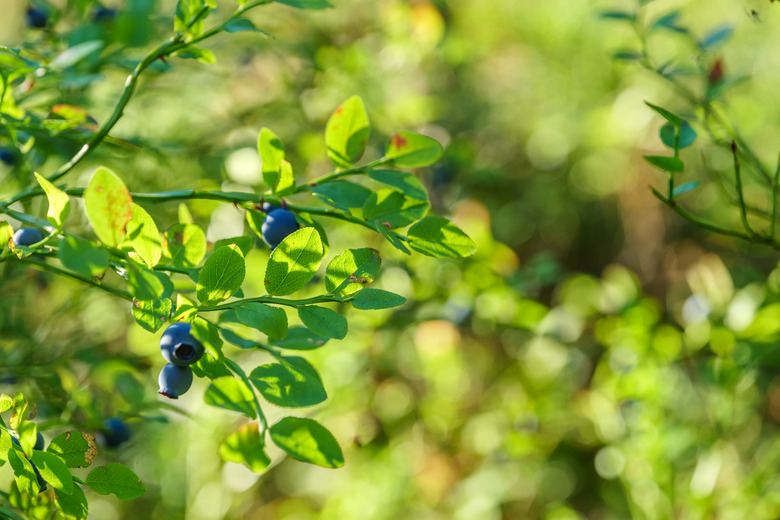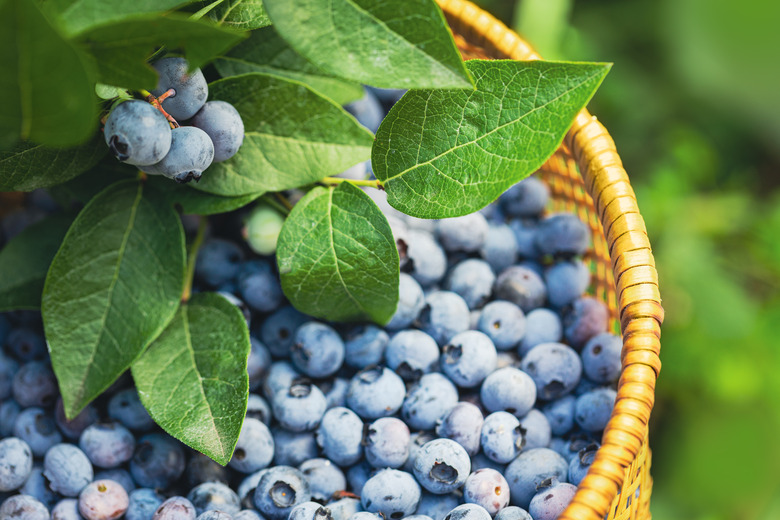How To Grow Huckleberries
We may receive a commission on purchases made from links.
Huckleberries (Vaccinium and Gaylussacia species) are a favorite find for foragers in areas such as the coniferous forests of the northwestern United States because of their delicious, sweet flavor. This perennial shrub has other common names, depending on species, such as thin-leafed huckleberry, mountain huckleberry, black huckleberry, or Southern dwarf huckleberry, .
Though related to the blueberry, many types of huckleberry are almost always found in the wild, as it's been difficult to domesticate, while blueberries are widely domesticated. The huckleberry is quite rare in plant nurseries and even rarer among commercial food growers. That said, many people try to grow it from seed or seedling, often without success. It takes several years for a new huckleberry plant to produce edible fruits, so growing this tasty treat is a long-term labor of love.
Best Uses for Huckleberries
Best Uses for Huckleberries
Huckleberry is cherished for the flavor of its fruit rather than for its looks in a landscape. This fruit is a tasty treat when found in the wild, and even birds, deer and bears love them. When fully ripe, the fruits are deep purple and even more flavorful than the average ripe blueberry. They're also high in vitamins A, B and C and are rich in antioxidants. In areas where huckleberries are abundant, they're collected and made into jams, cobblers and pies, and they are even used to flavor ice cream.
These berries were incredibly important to a number of Native American tribes that used them for foods and for dyes. Some native groups even held a huckleberry feast every year as a celebration of thanksgiving for abundance. Tribes often dried the fruits to preserve them during the colder-weather months as well.
How to Grow Huckleberries
How to Grow Huckleberries
How to Start Huckleberries From Seed
- Harvest your own huckleberry seeds from the fresh fruits if you are unable to find a good retail source.
- Press a few huckleberries through a strainer and over a glass to remove some of the fruit matter.
- Pour water over the strainer to force the tiny seeds through the strainer holes and into the glass and then pour that water back and forth a few times between two glasses.
- Let the glass containing the seeds settle for a few minutes and then remove any floating seeds. The seeds that do not float are the viable ones to keep.
- Fill a 4-inch pot with an azalea potting mix or your own blend containing one part damp peat moss, one part clean soil and two parts of a drainage material, such as sand or perlite.
- Press down the potting mix in the pot to compress it a little and then sprinkle a few of your fresh or store-bought seeds atop the soil followed by a thin layer of clean sand.
- Set the pot in a location where it will receive a fair amount of light and daytime temperatures around 75 degrees Fahrenheit. The nighttime air should be slightly cooler but at least 50 degrees or above.
- Water when the soil feels dry using a mister or sprayer and do not soak the soil, as it could wash away the seeds.
- In a month or two, the seeds should sprout. It takes one to two years until the seedlings are 6 inches tall and mature enough to plant in the ground. Until that time, place them in a greenhouse or outdoors as long as the nighttime temperatures stay above 30 degrees. The tiny sprouts can also be placed in a refrigerator to remain dormant until spring if you prefer. If you are keeping the pot indoors, the plant does best under grow lights for about 12 hours per day.
How to Start Huckleberries From a Seedling
Although it's difficult to find huckleberries in plant nurseries, some specializing in native plants carry them in regions where the wild huckleberry plants grow, such as parts of northern California and Idaho. Huckleberry is notoriously difficult to propagate and to grow in an area other than where it was found. This plant seems to prefer the specific soil, climate and elevation conditions in which its parent plant originated. Ask your grower about the source of the seedling, and if your yard's conditions are similar in elevation and soil composition, you'll have better luck getting it to grow in the ground.
- If possible, plant the seedling in soil that contains remnants of rotting wood. Burying a rotting log chunk about a year in advance is one way to ensure the soil has enough organic matter already in place when you plant the huckleberry seedling.
- Plant the seedling with as much of its original potting soil in place as possible to avoid disturbing the fickle huckleberry's root structure, as this plant does not do well if its roots have been disturbed.
- Plant it in a hole that's approximately the same depth as the plant pot housing the seedling.
- Once you've placed the seedling in its new hole, pack the soil gently atop it and then add several inches of bark mulch or wood chips.
- Keep the plant moist, watering whenever the ground appears dry. Also keep the area as weed-free as possible.
In What Zone Do Huckleberries Grow Best?
In What Zone Do Huckleberries Grow Best?
Although the huckleberry is a perennial in USDA plant hardiness zones 5 through 9, it's quite common in areas much farther north as well. It's not the climate zone that seems to be important to the huckleberry but rather the elevation and potentially the soil conditions. In the wild, it's often found as an understory plant in conifer forests and in areas where forest fires occurred. It's quite common in the Pacific Northwest and Canada but can be found as far east as parts of Minnesota and northern Michigan as well.
Huckleberries prefer somewhat high elevations, thriving at about 5,000 feet above sea level, although they will grow quite a bit lower and higher up as well. Once established, this plant does best in areas that have plenty of snow cover in winter. When it is still a seedling or very young, it should be protected if temperatures are predicted to reach below zero.
When Should You Plant Huckleberries?
When Should You Plant Huckleberries?
Plant huckleberries in early spring once the ground thaws or in autumn before the ground is consistently frozen. A layer of wood mulch or wood chips several inches thick atop the soil helps protect the young plant from extreme temperature fluctuations. Don't expect plants to flower within the first or even the second season in the ground. It takes two to five years on average for a huckleberry plant to produce blooms and up to five years to produce its first fruits. The plant may not produce an abundance of fruit until it's more mature, which could take up to 15 years from the time it was planted.
Soil, Sunlight and Water Recommendations for Huckleberries
Soil, Sunlight and Water Recommendations for Huckleberries
The huckleberry plant grows best on acidic soil with a pH of 4.5 to 5. Sandy loam full of decayed wood is ideal, as this plant is often found in areas where trees have burned. Areas that get filtered sun rather than full sun all day are ideal since the huckleberry often grows as an understory plant in forested areas.
While the huckleberry prefers a sandy soil, it also needs lots of moisture as it establishes itself. Be sure it receives water when the soil seems dry. Once it's established, the huckleberry is moderately drought tolerant.
How to Propagate Huckleberries
How to Propagate Huckleberries
Huckleberry can also be propagated by a rhizome (or a stem that grows underground) cutting, although it's quite difficult to achieve success with this plant. Breaking off a rhizome piece may also damage the existing huckleberry plant. If you are able to obtain a huckleberry rhizome, wait until late winter and look for part of the shallow-growing rhizome that is set off a bit from the main plant. Dig around it a bit to expose as much of it as possible.
- Select a section that looks healthy; it may have tiny rootlets beneath it.
- Cut off a 4-inch section of rhizome and then bury it in a couple inches of clean sand, keeping it in a 70-degree environment.
- Mist the sand regularly to keep it moist.
- Once the roots growing off the rhizome are 1 to 2 inches long, transplant the rhizome to a suitable pot and azalea potting mixture as with seeds.
Rhizomes are finicky, so you may not achieve success with this method.
How to Harvest Huckleberries
How to Harvest Huckleberries
Pick huckleberries when the berries are large and deep purple to almost black in color, which usually happens sometime between the middle of August and the end of September, although they may last through November. In some regions, they may be ripe as early as July. Huckleberries look like dark blueberries in size and shape when they are fully grown and ripe. The berries should be somewhat firm with a little give and deep in color.
- Gently tug or twist the berry; it should pull freely from the plant.
- Place the berries in a basket or bowl and be careful not to damage their skin.
Common Pests and Other Problems for Huckleberries
Common Pests and Other Problems for Huckleberries
Leafrollers, which also plague blueberry plants, are the main pest to cause problems for huckleberries. Leafrollers are moths such as the orange tortrix and the oblique banded leafroller. Both are similar, with bands of tan to brown or light-orange tones on their wings and bodies. As the name implies, this interesting species rolls up plant leaves and ties them with a silken matter, saving the leaves for both food and shelter for their larvae.
Look for oddly rolled leaves to determine whether your huckleberry plant has leafrollers. Munched leaves are another sign of potential damage from this pest. Parasitic moths are one treatment that helps get rid of leafrollers. Pheromone traps that capture male moths are another option for a serious infestation.
Common Diseases for Huckleberries
Common Diseases for Huckleberries
Like blueberries, huckleberries are susceptible to a problem called mummy berry, which gives some berries a mummified appearance. The first signs of this fungal-based disease are wilted or curled leaves. The entire stem generally wilts within a few days once this occurs.
Fungal spores transmitted by wind land on flowering huckleberry plants. As the fruits grow, they eventually shrivel and lose some of their size, often turning whitish, tan or gray. The fungus is inside the fruits and may not be obvious while the fruit is still immature unless you cut one open and see the white growth inside. Diseased berries eventually fall to the ground, where the fungus continues to thrive unless buried or treated. Cover the area in late fall with a 2-inch-thick layer of fir sawdust to help prevent future fungal infections.
Picking off the affected fruits as you see them, either on the plant or on the ground, is the best way to keep the fungus from thriving in the soil near the affected plant.
References
- United States Department of Agriculture: Vaccinium membranaceum Douglas ex Torr.
- Native Foods Nursery: Black Huckleberry
- The Oregon Encyclopedia: Blueberries and Huckleberries
- The Spokesman-Review: WSU Researchers Taming the Wild Huckleberry
- Portland Nursery: Vaccinium: Huckleberry
- Evergreen State College: Delectable Black Gold: Wild Mountain Huckleberry
- Pacific Northwest Pest Management Handbooks: Blueberry-Leafroller
- American Phytopathological Society: Mummy Berry
- United States Department of Agriculture: Gifford Pinchot National Forest Huckleberries
- Pacific Northwest Pest Management Handbooks: Blueberry (Vaccinium corymbosum)-Mummy Berry


